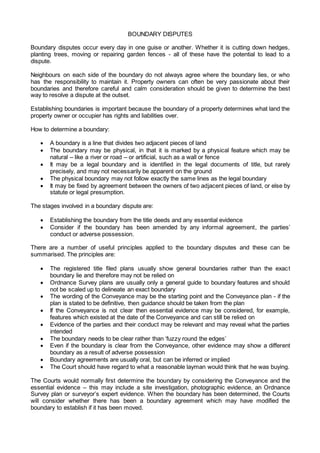
RH - Boundaries
- 1. BOUNDARY DISPUTES Boundary disputes occur every day in one guise or another. Whether it is cutting down hedges, planting trees, moving or repairing garden fences - all of these have the potential to lead to a dispute. Neighbours on each side of the boundary do not always agree where the boundary lies, or who has the responsibility to maintain it. Property owners can often be very passionate about their boundaries and therefore careful and calm consideration should be given to determine the best way to resolve a dispute at the outset. Establishing boundaries is important because the boundary of a property determines what land the property owner or occupier has rights and liabilities over. How to determine a boundary: A boundary is a line that divides two adjacent pieces of land The boundary may be physical, in that it is marked by a physical feature which may be natural – like a river or road – or artificial, such as a wall or fence It may be a legal boundary and is identified in the legal documents of title, but rarely precisely, and may not necessarily be apparent on the ground The physical boundary may not follow exactly the same lines as the legal boundary It may be fixed by agreement between the owners of two adjacent pieces of land, or else by statute or legal presumption. The stages involved in a boundary dispute are: Establishing the boundary from the title deeds and any essential evidence Consider if the boundary has been amended by any informal agreement, the parties’ conduct or adverse possession. There are a number of useful principles applied to the boundary disputes and these can be summarised. The principles are: The registered title filed plans usually show general boundaries rather than the exact boundary lie and therefore may not be relied on Ordnance Survey plans are usually only a general guide to boundary features and should not be scaled up to delineate an exact boundary The wording of the Conveyance may be the starting point and the Conveyance plan - if the plan is stated to be definitive, then guidance should be taken from the plan If the Conveyance is not clear then essential evidence may be considered, for example, features which existed at the date of the Conveyance and can still be relied on Evidence of the parties and their conduct may be relevant and may reveal what the parties intended The boundary needs to be clear rather than ‘fuzzy round the edges’ Even if the boundary is clear from the Conveyance, other evidence may show a different boundary as a result of adverse possession Boundary agreements are usually oral, but can be inferred or implied The Court should have regard to what a reasonable layman would think that he was buying. The Courts would normally first determine the boundary by considering the Conveyance and the essential evidence – this may include a site investigation, photographic evidence, an Ordnance Survey plan or surveyor’s expert evidence. When the boundary has been determined, the Courts will consider whether there has been a boundary agreement which may have modified the boundary to establish if it has been moved.
- 2. Litigation can be complex, uncertain and expensive. Parties can litigate over a tiny strip of land which is usually financially unwise, but a person remains entitled in law to protect and preserve that which is his or hers. However, before litigating, it might be worth considering how the dispute may be resolved amicably. Rukhsanah Haroon is a property expert at Newcastle law firm Sintons. For advice on any property related matter, contact her on 0191 226 7924 or Rukhsanah.haroon@sintons.co.uk